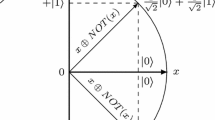Abstract
A direct relation between the complexity of the complete verification of keys, which is one of the main criteria of security in classical systems, and a trace distance used in quantum cryptography is demonstrated. Bounds for the minimum and maximum numbers of verification steps required to determine the actual key are obtained.
Similar content being viewed by others
References
Yu. I. Manin, Computable and Incomputable (Sov. Radio, Moscow, 1980) [in Russian].
R. P. Feynman, Int. J. Theor. Phys. 21, 467 (1982).
P. W. Shor, in Proceedings of the 35th Annual Symposium on Foundations of Computer Science, 1994, p. 124.
L. K. Grover, Phys. Rev. Lett. 79, 325 (1997).
Y. Ozhigov, Chaos Solitons Fractals 10, 1707 (1999).
C. Zalka, arXiv:quant-ph/9603026.
Quantum Algorithm Zoo. math.nist.gov/quantum/zoo/.
C. H. Bennett and G. Brassard, in Proceedings of the IEEE International Conference on Computers, Systems and Signal Processing, Bangalore, India, 1984, p. 175.
G. S. Vernam, J. IEEE 55, 109 (1926).
V. A. Kotel’nikov, Report (June 19, 1941).
C. Shannon, Bell System Tech. J. 28, 656 (1949).
R. Renner, PhD Thesis (ETH Zürich, 2005).
C. Portmann and R. Renner, arXiv:1409.3525[quantph].
H. P. Yuen, Phys. Rev. A 82, 062304 (2010); H. P. Yuen, arXiv:1109.1051 [quant-ph]; H. P. Yuen, arXiv:1109.2675 [quant-ph]; H. P. Yuen, arXiv:1109.1066 [quant-ph]; R. Renner, arXiv: 1209.2423 [quant-ph].
J. L. Massey, in Proceedings of the IEEE International Symposium on Information Theory, Guessing and Entropy, 1994, p. 204.
J. O. Pliam, PhD Thesis (Minnesota Univ., 1999).
T. M. Cover and J. A. Thomas, Elements of Information Theory (Wiley, Hoboken, NJ, 1991).
M. Nielsen and I. Chuang, Quantum Computation and Quantum Information (Cambridge Univ. Press, Cambridge, 2000).
A. de Santis, A. G. Gaggia, and U. Vaccaro, IEEE Trans. Inf. Theory 47, 468 (2001).
A. S. Holevo, Russ. Math. Surv. 53, 1295 (1998).
C. E. Shannon, Bell System Tech. J. 27, 379 (1948).
Author information
Authors and Affiliations
Corresponding author
Additional information
Original Russian Text © S.N. Molotkov, 2016, published in Zhurnal Eksperimental’noi i Teoreticheskoi Fiziki, 2016, Vol. 150, No. 5, pp. 903–916.
Rights and permissions
About this article
Cite this article
Molotkov, S.N. One-time pad, complexity of verification of keys, and practical security of quantum cryptography. J. Exp. Theor. Phys. 123, 784–795 (2016). https://doi.org/10.1134/S1063776116110169
Received:
Published:
Issue Date:
DOI: https://doi.org/10.1134/S1063776116110169



